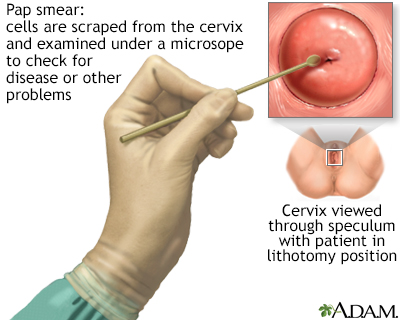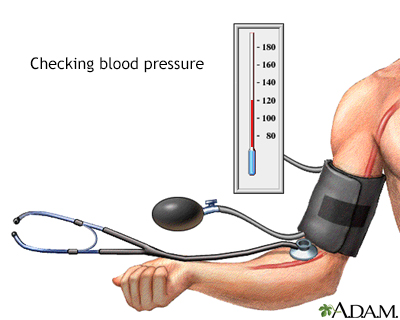Pregnancy SmartSiteTM
Health maintenance visit - women - ages 40 to 64; Physical exam - women - ages 40 to 64; Yearly exam - women - ages 40 to 64; Checkup - women - ages 40 to 64; Women's health - ages 40 to 64; Preventive care - women - ages 40 to 64 DefinitionYou should visit your health care provider from time to time, even if you are healthy. The purpose of these visits is to:
InformationEven if you feel fine, you should still see your provider for regular checkups. These visits can help you avoid problems in the future. For example, the only way to find out if you have high blood pressure is to have it checked regularly. High blood sugar and high cholesterol levels also may not have any symptoms in the early stages. A simple blood test can check for these conditions. There are specific times when you should see your provider or receive specific health screenings. The US Preventive Services Task Force publishes a list of recommended screenings. Below are screening guidelines for women ages 40 to 64. BLOOD PRESSURE SCREENING Have your blood pressure checked at least once every year. Watch for blood pressure screenings in your area. Ask your provider if you can stop in to have your blood pressure checked. You can also check your blood pressure using the automated machines that are often located at local grocery stores and pharmacies. Ask your provider if you need your blood pressure checked more often if:
If the top number is 130 mm Hg or greater, but lower than 140 mm Hg or the bottom number is 80 mm Hg or greater but lower than 90 mm Hg, this is considered to be stage 1 hypertension. Readings above these are considered to be stage 2 hypertension. Schedule an appointment with your provider to learn how you can reduce your blood pressure. Record your blood pressure numbers and bring this information to share with your provider. BREAST CANCER SCREENING Experts do not agree about the benefits of breast self-exams in finding breast cancer or saving lives. Talk to your provider about what is best for you. Mammography is performed to screen women to detect early breast cancer when it is more likely to be cured. The recommendations of different expert organizations can differ.
Mammograms work best at finding breast cancer in women ages 40 to 74. It is not clear how well mammograms work at finding cancer in women age 75 and older. If you have other risk factors for breast cancer, your provider may recommend an MRI scan for screening. CERVICAL CANCER SCREENING After starting cervical cancer screening:
If you have had your uterus and cervix removed (total hysterectomy), and you have not been diagnosed with cervical cancer or precancer (high grade cervical neoplasia), you do not need cervical cancer screening. CHOLESTEROL SCREENING Cholesterol screening should begin at:
Repeat cholesterol screening should take place:
Your provider may recommend testing more often if you are taking medicines to control high cholesterol. COLORECTAL CANCER SCREENING If you are under age 45, talk to your provider about getting screened. You should be screened if you have a strong family history of colon cancer or polyps. Screening may also be considered if you have risk factors such as a history of inflammatory bowel disease or polyps. If you are age 45 to 75, you should be screened for colorectal cancer. There are several screening tests available:
You may need a colonoscopy more often if you have risk factors for colorectal cancer, such as:
DENTAL EXAM
PREDIABETES AND TYPE 2 DIABETES SCREENING You should be screened for prediabetes and type 2 diabetes starting at age 35. Screening should be repeated every 3 years if you are overweight and have obesity. You should be tested more often if you have other risk factors for diabetes, such as:
EYE EXAM
IMMUNIZATIONS Commonly needed vaccines include:
Ask your provider if you should receive other immunizations if you have certain health problems that increase your risk for some diseases such as pneumonia. INFECTIOUS DISEASE SCREENING Screening for hepatitis C:
Screening for human immunodeficiency virus (HIV): all people ages 15 to 65 should get a one-time test. Depending on your lifestyle and medical history, you may need to be screened for infections such as syphilis, chlamydia, and other infections. LUNG CANCER SCREENING You should have an annual screening for lung cancer with low-dose computed tomography (LDCT) if all of the following are present:
OSTEOPOROSIS SCREENING If you are age 50 to 64 and have risk factors for osteoporosis, you should discuss screening with your provider. Risk factors can include long-term steroid use, low body weight, smoking, heavy alcohol use, having a fracture after age 50, or a family history of hip fracture or osteoporosis. PHYSICAL EXAM All adults should visit their provider from time to time, even if they are healthy. The purpose of these visits is to:
Your blood pressure, height, weight, and body mass index (BMI) should be checked at each exam. During your exam, your provider may ask you about:
SKIN EXAM Your provider may check your skin for signs of skin cancer, especially if you're at high risk. You may be at high risk if you:
Professional organizations do not recommend for or against performing a skin self-exam. ReferencesAmerican Academy of Ophthalmology website. Comprehensive adult medical eye examination PPP 2020. www.aao.org/education/preferred-practice-pattern/comprehensive-adult-medical-eye-evaluation-ppp. Updated November 2020. Accessed May 20, 2024. American Cancer Society website. Breast cancer early detection and diagnosis: American Cancer Society recommendations for the early detection of breast cancer. www.cancer.org/cancer/breast-cancer/screening-tests-and-early-detection/american-cancer-society-recommendations-for-the-early-detection-of-breast-cancer.html. Updated December 19, 2023. Accessed May 20, 2024. American College of Obstetricians and Gynecologists (ACOG) website. FAQ178: Mammography and other screening tests for breast problems. www.acog.org/patient-resources/faqs/gynecologic-problems/mammography-and-other-screening-tests-for-breast-problems. Updated July 2022. Accessed May 20, 2024. American College of Obstetricians and Gynecologists. FAQ163: Cervical cancer. www.acog.org/patient-resources/faqs/gynecologic-problems/cervical-cancer. Updated October 2023. Accessed May 20, 2024. American Dental Association website. Your top 9 questions about going to the dentist -- answered! www.mouthhealthy.org/en/dental-care-concerns/questions-about-going-to-the-dentist. Accessed May 20, 2024. American Diabetes Association Professional Practice Committee. 2. Diagnosis and classification of diabetes: standards of care in diabetes-2024. Diabetes Care. 2024;47(Suppl 1):S20-S42. PMID: 38078589; PMCID: PMC10725812. pubmed.ncbi.nlm.nih.gov/38078589/. Barton MB, Wolff TA. The preventive health visit. In: Goldman L, Cooney K, eds. Goldman-Cecil Medicine. 27th ed. Philadelphia, PA: Elsevier; 2024:chap 12. Brown HL, Warner JJ, Gianos E, et al; American Heart Association and the American College of Obstetricians and Gynecologists. Promoting risk identification and reduction of cardiovascular disease in women through collaboration with obstetricians and gynecologists: a presidential advisory from the American Heart Association and the American College of Obstetricians and Gynecologists. Circulation. 2018;137(24):e843-e852. PMID: 29748185 pubmed.ncbi.nlm.nih.gov/29748185/. Centers for Disease Control and Prevention website. Recommended Vaccinations for Adults. Recommended Immunizations for adults aged 19 years and older, United States, 2024. www.cdc.gov/vaccines/imz-schedules/adult-easyread.html. Updated August 14, 2024. Accessed September 26, 2024. Grundy SM, Stone NJ, Bailey AL, et al. 2018 AHA/ACC/AACVPR/AAPA/ABC/ACPM/ADA/AGS/APhA/ASPC/NLA/PCNA Guideline on the management of blood cholesterol: a report of the American College of Cardiology/American Heart Association Task Force on Clinical Practice Guidelines [published correction appears in J Am Coll Cardiol. 2019;73(24):3237-3241]. J Am Coll Cardiol. 2019;73(24):e285-e350. PMID: 30423393 pubmed.ncbi.nlm.nih.gov/30423393/. Meschia JF, Bushnell C, Boden-Albala B; American Heart Association Stroke Council; et al. Guidelines for the primary prevention of stroke: a statement for healthcare professionals from the American Heart Association/American Stroke Association. Stroke. 2014;45(12):3754-3832. PMID: 25355838 pubmed.ncbi.nlm.nih.gov/25355838/. Mora S, Libby P, Ridker PM. Primary prevention of cardiovascular disease. In: Libby P, Bonow RO, Mann DL, Tomaselli GF, Bhatt DL, Solomon SD, eds. Braunwald's Heart Disease: A Textbook of Cardiovascular Medicine. 12th ed. Philadelphia, PA: Elsevier; 2022:chap 25. National Cancer Institute website. Breast cancer screening (PDQ) - health professional version. www.cancer.gov/types/breast/hp/breast-screening-pdq. Updated March 28, 2024. Accessed May 20, 2024. US Preventive Services Task Force website. Final recommendation statement. Breast cancer: medication use to reduce risk. www.uspreventiveservicestaskforce.org/uspstf/recommendation/breast-cancer-medications-for-risk-reduction. Updated September 3, 2019. Accessed May 20, 2024. US Preventive Services Task Force; Nicholson WK, Silverstein M, Wong JB, Barry MJ, Chelmow D, Coker TR, Davis EM, Jaén CR, Krousel-Wood M, Lee S, Li L, Mangione CM, Rao G, Ruiz JM, Stevermer JJ, Tsevat J, Underwood SM, Wiehe S. Screening for breast cancer: US Preventive Services Task Force Recommendation Statement. JAMA. 2024 Apr 30. Epub ahead of print. PMID: 38687503. pubmed.ncbi.nlm.nih.gov/38687503/. US Preventive Services Task Force website. Final recommendation statement. Cervical cancer: screening. www.uspreventiveservicestaskforce.org/uspstf/recommendation/cervical-cancer-screening. Published August 21, 2018. Accessed May 20, 2024. US Preventive Services Task Force website. Final recommendation statement. Colorectal cancer: screening. www.uspreventiveservicestaskforce.org/uspstf/recommendation/colorectal-cancer-screening. Published May 18, 2021. Accessed May 20, 2024. US Preventive Services Task Force website. Falls prevention in community-dwelling older adults: Interventions. www.uspreventiveservicestaskforce.org/uspstf/recommendation/falls-prevention-community-dwelling-older-adults-interventions. Published June 4, 2024. Accessed July 3, 2024. US Preventive Services Task Force website. Final recommendation statement. Hepatitis C virus infection in adolescents and adults: screening. www.uspreventiveservicestaskforce.org/uspstf/recommendation/hepatitis-c-screening. Published March 2, 2020. Accessed May 20, 2024. US Preventive Services Task Force website. Final recommendation statement. Human immunodeficiency virus (HIV) infection: screening. www.uspreventiveservicestaskforce.org/uspstf/recommendation/human-immunodeficiency-virus-hiv-infection-screening. Published June 11, 2019. Accessed May 20, 2024. US Preventive Services Task Force website. Hypertension in adults: screening. www.uspreventiveservicestaskforce.org/uspstf/recommendation/hypertension-in-adults-screening. Published April 27, 2021. Accessed May 20, 2024. US Preventive Services Task Force website. Final recommendation statement: Lung cancer: Screening. www.uspreventiveservicestaskforce.org/uspstf/recommendation/lung-cancer-screening. Updated March 9, 2021. Accessed May 20, 2024. US Preventive Services Task Force website. Final recommendation statement: osteoporosis to prevent fractures: screening. www.uspreventiveservicestaskforce.org/uspstf/recommendation/osteoporosis-screening. Updated June 26, 2018. Accessed May 20, 2024. US Preventive Services Task Force website. Prediabetes and type 2 diabetes: screening. www.uspreventiveservicestaskforce.org/uspstf/recommendation/screening-for-prediabetes-and-type-2-diabetes. Updated August 24, 2021. May 20, 2024. US Preventive Services Task Force website. Skin cancer: screening. www.uspreventiveservicestaskforce.org/uspstf/recommendation/skin-cancer-screening. Updated April 18, 2023. Accessed May 20, 2024. Whelton PK, Carey RM, Mancia G, Kreutz R, Bundy JD, Williams B. Harmonization of the American College of Cardiology/American Heart Association and European Society of Cardiology/European Society of Hypertension Blood Pressure/Hypertension Guidelines: Comparisons, reflections, and recommendations. Circulation. 2022;146:868-877. pubmed.ncbi.nlm.nih.gov/35950927/. | |
| |
Review Date: 5/21/2024 Reviewed By: Jacob Berman, MD, MPH, Clinical Assistant Professor of Medicine, Division of General Internal Medicine, University of Washington School of Medicine, Seattle, WA. Also reviewed by David C. Dugdale, MD, Medical Director, Brenda Conaway, Editorial Director, and the A.D.A.M. Editorial team. Editorial update 09/26/2024. The information provided herein should not be used during any medical emergency or for the diagnosis or treatment of any medical condition. A licensed medical professional should be consulted for diagnosis and treatment of any and all medical conditions. Links to other sites are provided for information only -- they do not constitute endorsements of those other sites. No warranty of any kind, either expressed or implied, is made as to the accuracy, reliability, timeliness, or correctness of any translations made by a third-party service of the information provided herein into any other language. © 1997- A.D.A.M., a business unit of Ebix, Inc. Any duplication or distribution of the information contained herein is strictly prohibited. | |

 Mammogram
Mammogram Pap smear
Pap smear Effects of age on ...
Effects of age on ... Osteoporosis
Osteoporosis Fecal occult blood...
Fecal occult blood... Squamous cell canc...
Squamous cell canc...
